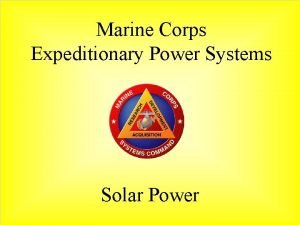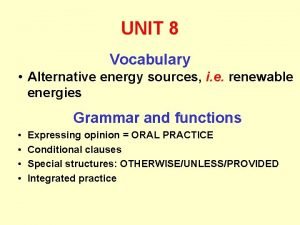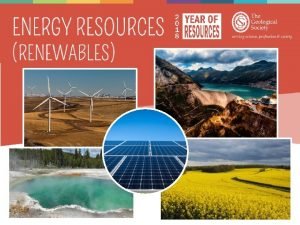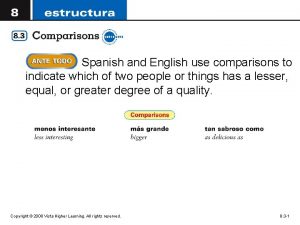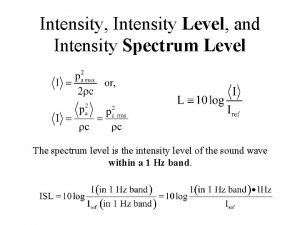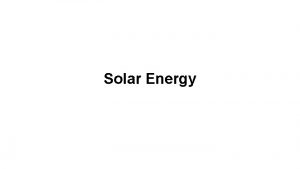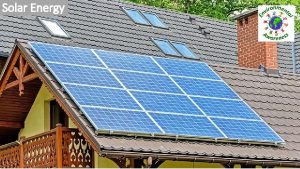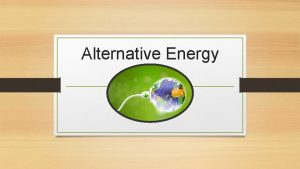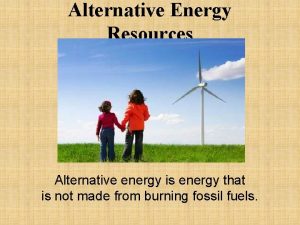Alternative Energy Solar PV Comparisons Solar Intensity vs












- Slides: 12

Alternative Energy Solar PV Comparisons

Solar Intensity vs Light emitted by the hot photosphere is reduced by light absorbed or scattered by the solar corona, atmospheric molecules, dust, and clouds. This includes the climate changing effects (absorption/re-emission) by carbon dioxide, methane, and water vapor.

Solar Power Available Top of the Atmosphere 1366 W/m 2 Peak Surface Insolation 1000 W/m 2 Typical average 6 k. Wh/m 2 /day (latitude, weather, hours of sunlight) 1 k. Wh/day requires 0. 17 m 2 Allowing for PV efficiency 0. 85 m 2 (20% Si PV)

Satisfying Total US Electric Needs Total Electric energy consumed 15 4. 3 x 1012 1. 1 x 1010 Avg power needed 490 The avg US home uses energy at the rate of 750 18 This would require 1. 9 x 109 Area covered by solar panels Percent of total US Land area Percent of Mojave Desert 1900 0. 05 % 6% Quad k. Wh/yr k. Wh/day GW W k. Wh/day m 2 mi 2

Costs Annual Electric energy Electric Power capacity avg A plant averaging 1 GW will produce Cost to build new 1 GW plant $ per W Solar Wind Natural Gas-fired Turbine Nuclear $3. 0 $1. 8 $1. 0 $6. 0 4. 3 x 1012 k. Wh/yr 490 GW 8760 GWh/yr CF $ investment 21% 30% 85% $14 billion $6 billion $1 billion $7 billion (US GNP = $13 Trillion / yr) Cost to produce Solar Natural Gas Turbine Nuclear Wind $ per k. Wh Annual Cost $0. 012 $0. 075 $0. 023 $0. 045 $51 billion $320 billion $100 billion $190 billion

Key Energy Surprises 1. 2. 3. 4. 5. 6. Gasoline delivers 15 times the energy of an equal weight of TNT. Coal is 20 times cheaper than gasoline, for the same energy. A square mile of sunlight at midday could provide a gigawatt of electric power – the same as a large coal, electric, or nuclear power plant. A square meter of sunlight delivers about a horsepower (746 W) when it hits the ground, the same as the average electric power used by a US household. Gasoline has 1000 times as much energy as an equal weight of flashlight batteries, and 100 times as much as an equal weight of expensive computer batteries. Liquid hydrogen, the key fuel for a future “hydrogen economy, ” has 4. 5 times less energy per gallon than gasoline has. “Physics for Future Presidents” by Richard A. Muller

Energy Content per pound compared to Gasoline & Electricity Fuel Gasoline Choc chip cookies TNT Natural Gas Hydrogen Uranium Fusion Antimatter x Gas 1 0. 5 0. 07 1. 3 2. 6 2 M 6 M 2 B Energy content 8. 0 k. Wh/lb 4. 0 0. 5 10 21 1. 6 x 106 4. 7 x 1010 1. 6 x 109 (Average cost of energy in SLO = $0. 126/k. Wh) $ Elec $1. 01 $0. 50 $0. 06 $1. 26 $2. 64 $200 K $600 K $200 M

“Should solar photovoltaics be deployed sooner because of long operating life at low, predictable cost? ” By Ken Zweibel Solar Institute, The George Washington University Fig. 4, The switch in year 20 emphasizes the level of capital cost in each option. The steady-state costs afterward are just fuel and operating costs.

Fig. 7. Annual electricity cost if there is 3% fuel inflation. This shows the results of possible fuel price escalations. Natural gas, because fuel is its largest component, rises the most, followed by coal with sequestration and traditional coal.

Fig. 8. The levelized cost of electricity of these options assuming 3% fuel inflation and a zero discount rate. Once again, wind and PV retain excellent prices throughout the 100 year period while everything else becomes expensive.

California Valley PV Projects Topaz Solar Farm 550 MW, thin-film PV, operational by 2015 $2 B Opti Solar > First Solar > Mid. American Energy Holdings (Warren Buffet) California Valley Solar Ranch 250 MW, PV, operational by 2013 $1. 6 B Sun. Power > NRG Carrizo Energy Solar Farm 177 MW, solar thermal, Cancelled 2009 $550 M Ausra Currently (Jan 2012) in the US there are 1300 MW of Utility-Scale Solar Projects in operation, with 4, 600 more in construction and 24, 000 under development.

Silicon PV Band Gap Bandgap Energy Bandgap energy is the amount of energy required to dislodge an electron from its covalent bond allow it to become part of an electrical circuit. When light shines on crystalline silicon, electrons within its crystal lattice may be freed. But not all photons—as packets of light energy are called—are created equal. To free an electron, the energy of a photon must be at least as great as the bandgap energy. However, photons with more energy than the bandgap energy will expend the extra as heat when freeing electrons. So it is important for a photovoltaic (PV) cell to be "tuned"—through slight modifications to the silicon's molecular structure—to optimize the photon energy. Crystalline silicon has a bandgap energy of 1. 1 electron-volts (e. V). (An electron-volt is equal to the energy gained by an electron when it passes through a potential of 1 volt in a vacuum. ) The bandgap energies of other effective PV semiconductors range from 1. 0 to 1. 6 e. V. In this range, electrons can be freed without creating extra heat. The photon energy of light varies according to the wavelengths of the light. The entire spectrum of sunlight, from infrared to ultraviolet, covers a range of about 0. 5 e. V to about 2. 9 e. V. For example, red light has an energy of about 1. 7 e. V, and blue light has an energy of about 2. 7 e. V. Most PV cells cannot use about 55% of the energy of sunlight because this energy is either below the bandgap of the material used or carries excess energy. Different PV materials have different energy band gaps. Photons with energy equal to the band gap energy are absorbed to create free electrons. Photons with less energy than the band gap energy pass through the material.
 Pv&e
Pv&e What is an inexhaustible source of energy
What is an inexhaustible source of energy Indirect solar energy
Indirect solar energy Energy energy transfer and general energy analysis
Energy energy transfer and general energy analysis Energy energy transfer and general energy analysis
Energy energy transfer and general energy analysis Renewable resources of energy definition
Renewable resources of energy definition Alternative energy vocabulary
Alternative energy vocabulary Ppt on alternative sources of energy
Ppt on alternative sources of energy Wholesalesolar com
Wholesalesolar com Comparisons of equality spanish
Comparisons of equality spanish Figure of speech comparing one thing to another
Figure of speech comparing one thing to another Comparative superlative good
Comparative superlative good Pictures to make comparisons
Pictures to make comparisons
